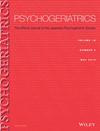Association of lipid levels with motor and cognitive function and decline in Parkinson's disease
IF 1.7
4区 医学
Q3 GERIATRICS & GERONTOLOGY
引用次数: 0
Abstract
BackgroundMost studies have focused on comparing blood lipid biomarkers between Parkinson's disease (PD) and normal controls (NC). However, further research is necessary to explore the impact of blood lipid levels on motor and cognitive function, as well as the progression of motor dysfunction and cognitive decline over time. Thus, the aim of this study is to investigate the relationship between blood lipid biomarkers and these indicators in individuals with PD.MethodsThe cohort study enrolled 157 PD patients and 146 NC from the Tianjin Huanhu Hospital from September 2017 to September 2019. Serum lipid fractions were detected in fasting serum samples. PD patients were followed up at 2 ± 0.6 years for clinical assessment.ResultsPD patients exhibited lower serum triglyceride (TG) levels as compared to NC (血脂水平与帕金森病患者运动和认知功能及衰退的关系
背景大多数研究都侧重于比较帕金森病(PD)和正常对照组(NC)之间的血脂生物标志物。然而,有必要进一步研究血脂水平对运动和认知功能的影响,以及随着时间的推移运动功能障碍和认知功能下降的进展。因此,本研究旨在探讨PD患者的血脂生物标志物与这些指标之间的关系。方法该队列研究于2017年9月至2019年9月在天津环湖医院招募了157名PD患者和146名NC。在空腹血清样本中检测血清脂质组分。结果与NC相比,PD患者的血清甘油三酯(TG)水平较低(P = 0.008)。与女性患者相比,PD 男性患者的血清脂蛋白胆固醇(LDL-C)和总胆固醇(TC)水平较低(LDL-C:P = 0.034;TC:P = 0.019)。血清 TG 水平与 PD 患者的统一 PD 评定量表 III、Hoehn 和 Yahr 分期以及蒙特利尔认知评估评分有显著相关性。此外,在调整回归模型中,PD 患者的血清 TG 水平与后续运动功能下降和认知功能下降相关。
本文章由计算机程序翻译,如有差异,请以英文原文为准。
求助全文
约1分钟内获得全文
求助全文
来源期刊

Psychogeriatrics
Medicine-Geriatrics and Gerontology
CiteScore
3.60
自引率
5.00%
发文量
115
审稿时长
>12 weeks
期刊介绍:
Psychogeriatrics is an international journal sponsored by the Japanese Psychogeriatric Society and publishes peer-reviewed original papers dealing with all aspects of psychogeriatrics and related fields
The Journal encourages articles with gerontopsychiatric, neurobiological, genetic, diagnostic, social-psychiatric, health-political, psychological or psychotherapeutic content. Themes can be illuminated through basic science, clinical (human and animal) studies, case studies, epidemiological or humanistic research
 求助内容:
求助内容: 应助结果提醒方式:
应助结果提醒方式:


